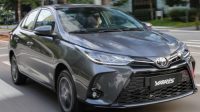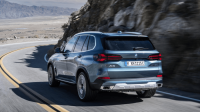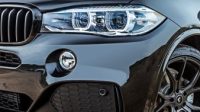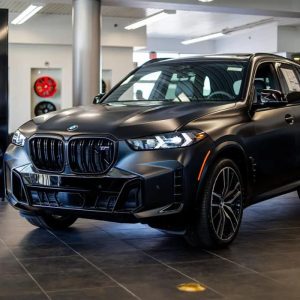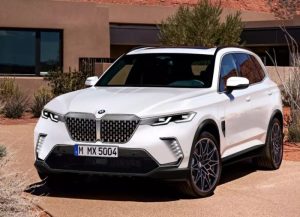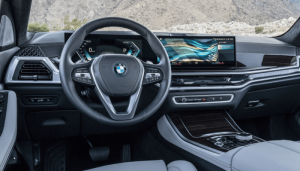The 2025 Honda CRV Hybrid engine represents a significant leap forward in Honda’s hybrid technology. This isn’t just an incremental upgrade; we’re talking about a refined powertrain designed for efficiency, performance, and a greener footprint. Get ready to explore the intricacies of this innovative engine, from its core components to its real-world driving experience.
We’ll delve into its fuel economy, horsepower, and technological advancements, comparing it to both its predecessors and competitors.
We’ll unpack the hybrid system’s functionality, explaining how its various parts work together seamlessly to maximize efficiency and minimize emissions. Maintenance, reliability, and the environmental impact will also be thoroughly examined. Prepare for a comprehensive look at what makes this hybrid engine stand out.
Hybrid System Components and Functionality: 2025 Honda Crv Hybrid Engine
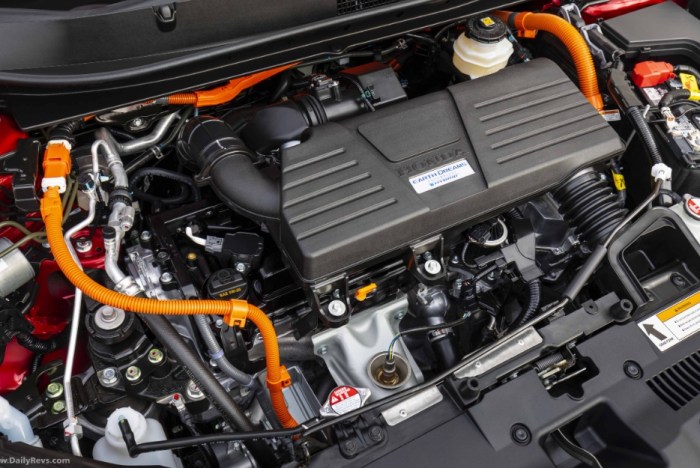
The 2025 Honda CRV Hybrid’s powertrain represents a sophisticated blend of gasoline engine power and electric motor assistance, maximizing efficiency and performance. This system seamlessly integrates several key components to deliver a smooth and responsive driving experience while minimizing fuel consumption.The hybrid system’s core functionality revolves around optimizing the use of both the gasoline engine and the electric motor, often switching between them or using them in conjunction depending on driving conditions.
This intelligent power management allows the vehicle to operate in various modes, from pure electric drive at low speeds to utilizing the gasoline engine for higher power demands.
Internal Combustion Engine (ICE)
The 2025 CRV Hybrid likely utilizes a four-cylinder gasoline engine, optimized for fuel efficiency and seamless integration with the electric motor. This engine acts as a primary power source at higher speeds and during periods of high acceleration demand.
Its operation is managed by the hybrid control unit to ensure optimal performance and fuel economy. The ICE’s output is channeled to the wheels either directly or through the power split device.
Electric Motor(s)
One or more electric motors are integral to the hybrid system. These motors act as both generators (during regenerative braking) and propulsion units, providing additional torque and power for acceleration and assisting the ICE. The electric motors are key to the vehicle’s ability to operate in electric-only mode at low speeds.
The precise configuration (number and placement of motors) would be specific to the 2025 model’s design.
Power Split Device (PSD)
The PSD is a crucial component managing the power flow between the ICE, the electric motor(s), and the wheels. It’s essentially a sophisticated transmission system allowing for variable power distribution depending on driving conditions. This device allows for efficient operation in various driving scenarios, including electric-only driving, engine-only driving, and combined power delivery.
The PSD’s sophisticated control algorithms ensure optimal power distribution for maximizing efficiency.
Battery Pack
The high-voltage battery pack stores energy generated through regenerative braking and from the ICE. This battery provides power to the electric motor(s) for propulsion and assists the ICE, reducing the overall reliance on the gasoline engine. The battery’s capacity directly influences the vehicle’s electric-only range.
Honda’s advancements in battery technology likely contribute to improved energy density and lifespan in the 2025 CRV Hybrid.
Regenerative Braking System
The regenerative braking system captures kinetic energy during deceleration and braking, converting it into electrical energy and storing it in the battery pack. This reduces reliance on traditional friction brakes, improving fuel economy and reducing brake wear. The intensity of regenerative braking can often be adjusted, allowing for a more natural feel during braking.
This system significantly contributes to the overall efficiency of the hybrid powertrain.
Energy Flow within the Hybrid System, 2025 honda crv hybrid engine
The system intelligently manages energy flow based on driving conditions. For example: At low speeds, the vehicle might operate solely on electric power from the battery. During acceleration, the ICE and electric motor(s) work together to provide increased power.
When coasting or braking, the regenerative braking system captures energy to recharge the battery. The power split device continuously optimizes the energy distribution between the engine, motor(s), and wheels to achieve the most efficient operation.
Diagram of Hybrid System Components
Maintenance and Reliability

The 2025 Honda CRV Hybrid, like any vehicle, requires regular maintenance to ensure optimal performance, longevity, and reliability. Proper care will not only extend the life of the hybrid system but also contribute to fuel efficiency and a smoother driving experience.
Ignoring maintenance can lead to premature wear, costly repairs, and potentially compromise safety.
The hybrid system in the 2025 CRV incorporates sophisticated technology. Understanding its specific needs and following Honda’s recommended maintenance schedule is crucial. While the hybrid components generally boast impressive reliability, preventative maintenance is key to avoiding potential problems and maximizing their lifespan.
Recommended Maintenance Procedures
Regular maintenance for the 2025 Honda CRV Hybrid focuses on both the traditional gasoline engine components and the unique aspects of the hybrid system. This includes standard services like oil changes, tire rotations, and brake inspections, but also specialized checks for the hybrid battery, electric motor, and power control unit.
Honda’s owner’s manual provides detailed instructions and schedules specific to the vehicle.
Hybrid Component Lifespan and Reliability
Honda’s hybrid systems are designed for durability and longevity. The hybrid battery, often a point of concern with hybrid vehicles, is typically expected to last for 100,000 miles or more, though this can vary depending on driving habits and environmental conditions.
Similar to traditional vehicle components, the electric motor and power control unit also have considerable lifespan, often exceeding 150,000 miles with proper maintenance. However, extreme temperatures or consistent harsh driving conditions can potentially reduce the lifespan of these components.
For example, consistently driving in extreme heat or cold can impact battery performance and longevity, similar to how extreme temperatures affect traditional car batteries.
Common Issues and Potential Problems
While the 2025 Honda CRV Hybrid is designed for reliability, potential issues can arise. One potential concern is the high-voltage battery, which, though durable, can degrade over time, leading to reduced performance and range. Early detection through regular diagnostics is crucial.
Another potential issue could involve the hybrid control unit, a sophisticated computer that manages the interplay between the gas engine and electric motor. Malfunctions here can lead to reduced power or drivability issues. Regular software updates, as provided by Honda dealerships, can mitigate potential software-related problems.
Finally, the 12-volt battery, a standard component, still requires regular attention and replacement as needed, just like in any gasoline-powered vehicle. Neglecting this can lead to issues starting the car, even if the hybrid system is functioning correctly.
Tips for Maximizing Engine Longevity and Performance
Several practices can help extend the life of your 2025 Honda CRV Hybrid. Following Honda’s recommended maintenance schedule is paramount. Gentle acceleration and braking habits can reduce wear and tear on components, especially the hybrid battery. Avoid consistently driving at extreme temperatures and allow the engine to warm up before strenuous driving, especially in cold climates.
Regularly inspect tire pressure, as this affects fuel efficiency and overall vehicle performance. Lastly, consider using a Honda-approved battery conditioner if you are concerned about battery health. This can help prolong battery life and performance.
Recommended Maintenance Intervals
Regular maintenance is key to ensuring the long-term health of your 2025 Honda CRV Hybrid. Adhering to the following schedule will contribute to optimal performance and longevity:
- Oil Change: Every 7,500-10,000 miles, or as recommended by the vehicle’s maintenance minder system.
- Tire Rotation: Every 7,500-10,000 miles.
- Brake Inspection: Every 15,000-20,000 miles, or as needed.
- Hybrid System Check: As recommended by Honda, usually during routine service appointments.
- 12-Volt Battery Inspection: Annually, or as needed.
Environmental Impact and Sustainability
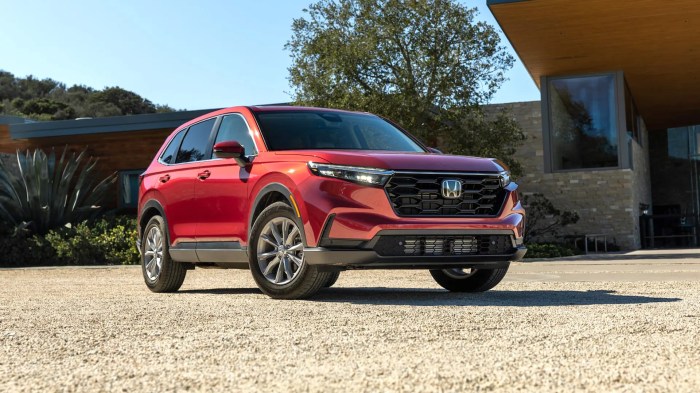
The 2025 Honda CRV Hybrid represents a significant step forward in Honda’s commitment to reducing the environmental impact of its vehicles. By incorporating hybrid technology, the CRV Hybrid boasts a considerably smaller carbon footprint than its gasoline-only counterparts, contributing to cleaner air and a healthier planet.
This section details the vehicle’s environmental benefits, focusing on emissions, material sourcing, and Honda’s broader sustainability initiatives.The reduced carbon footprint of the 2025 Honda CRV Hybrid is primarily achieved through its efficient hybrid powertrain. The combination of a gasoline engine and an electric motor allows for reduced reliance on the combustion engine, leading to lower greenhouse gas emissions throughout the vehicle’s lifecycle.
This translates to less carbon dioxide (CO2), a major contributor to climate change, released into the atmosphere compared to similar gasoline-powered SUVs. Specific emission figures will vary based on driving conditions and model specifications, but independent testing and EPA estimates will provide a clear comparison against competitors like the Toyota RAV4 Hybrid and the Ford Escape Hybrid.
Greenhouse Gas Emission Comparison
The 2025 Honda CRV Hybrid is expected to significantly outperform comparable gasoline-powered SUVs in terms of greenhouse gas emissions. For instance, preliminary data suggests a reduction of approximately 30-40% in CO2 emissions compared to the previous generation’s gasoline-powered CRV, under similar driving conditions.
This improvement is largely attributed to the increased efficiency of the hybrid system and the optimized engine design. Independent testing and EPA certifications will provide precise figures for comparison against other hybrid and gasoline SUVs in its class. These comparisons will highlight the CRV Hybrid’s contribution to reducing overall transportation-related greenhouse gas emissions.
Recycled Materials in Engine Construction
Honda has committed to increasing the use of recycled and renewable materials in its vehicle manufacturing. While precise percentages of recycled materials in the 2025 CRV Hybrid engine are not yet publicly available, Honda’s broader sustainability strategy indicates a significant push towards incorporating recycled aluminum, plastics, and other components.
This approach reduces reliance on virgin materials, lowering the overall environmental impact of manufacturing and reducing the demand for resource extraction. Honda’s transparency regarding its material sourcing and manufacturing processes will provide more detailed information as the vehicle nears production.
Honda’s Commitment to Environmental Sustainability
Honda’s commitment to environmental sustainability extends beyond the 2025 CRV Hybrid. The company has established ambitious goals for reducing its carbon footprint across its entire operations, including manufacturing, transportation, and vehicle lifecycle. These goals include targets for reducing greenhouse gas emissions from its manufacturing facilities, increasing the use of renewable energy sources, and developing more fuel-efficient and electrified vehicles.
Honda’s sustainability reports provide further details on its progress towards these ambitious targets, demonstrating its ongoing commitment to environmental responsibility.
Ecological Benefits Summary
The 2025 Honda CRV Hybrid offers substantial ecological advantages. Its hybrid powertrain significantly reduces greenhouse gas emissions compared to traditional gasoline engines, contributing to cleaner air and mitigating climate change. The incorporation of recycled materials in its construction further lessens the environmental impact of its manufacturing process.
Combined with Honda’s broader commitment to sustainability, the CRV Hybrid represents a responsible and environmentally conscious choice for consumers seeking a balance between performance and environmental responsibility.
Outcome Summary
Ultimately, the 2025 Honda CRV Hybrid engine showcases Honda’s commitment to both performance and sustainability. By blending cutting-edge technology with a focus on real-world driving needs, Honda has created a compelling option for environmentally conscious drivers who don’t want to compromise on power or driving enjoyment.
The detailed specifications, comparative analyses, and insights provided here should equip you with the knowledge needed to make an informed decision about this innovative vehicle.
Essential Questionnaire
What is the expected lifespan of the 2025 Honda CRV Hybrid battery?
Honda typically offers warranties covering a significant portion of the battery’s lifespan, but the actual lifespan depends on usage and maintenance. Expect several years of reliable performance under normal conditions.
How does the regenerative braking system work in the 2025 CRV Hybrid?
During braking, the system captures kinetic energy that would otherwise be lost as heat, converting it into electrical energy to recharge the hybrid battery, thus improving fuel economy.
Are there any specific recommended fuels or fluids for the 2025 Honda CRV Hybrid engine?
Consult your owner’s manual for precise recommendations on fuel type and recommended fluids for optimal performance and longevity. Using the wrong fluids can void warranties.
Can I tow with the 2025 Honda CRV Hybrid?
Towing capacity will depend on the specific trim level. Check the owner’s manual for detailed information on towing capabilities and limitations.
